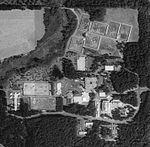Oregon Center for Advanced Technology Education
1985 establishments in Oregon2006 disestablishments in OregonEducational institutions established in 1985Portland State UniversitySchools in Hillsboro, Oregon
Oregon Center for Advanced Technology Education (OCATE) was a school in Hillsboro, Oregon, created by the state of Oregon to improve technology education. Established in 1985, the program was a collaboration of most of Oregon’s public universities. OCATE later was absorbed by Portland State University and discontinued in 2006.
Excerpt from the Wikipedia article Oregon Center for Advanced Technology Education (License: CC BY-SA 3.0, Authors).Oregon Center for Advanced Technology Education
Northeast Walker Road, Hillsboro Amberglen
Geographical coordinates (GPS) Address Phone number Website Nearby Places Show on map
Geographical coordinates (GPS)
| Latitude | Longitude |
|---|---|
| N 45.5273 ° | E -122.86984 ° |
Address
Beaverton Academy of Science and Engineering
Northeast Walker Road 10740
97006 Hillsboro, Amberglen
Oregon, United States
Open on Google Maps







